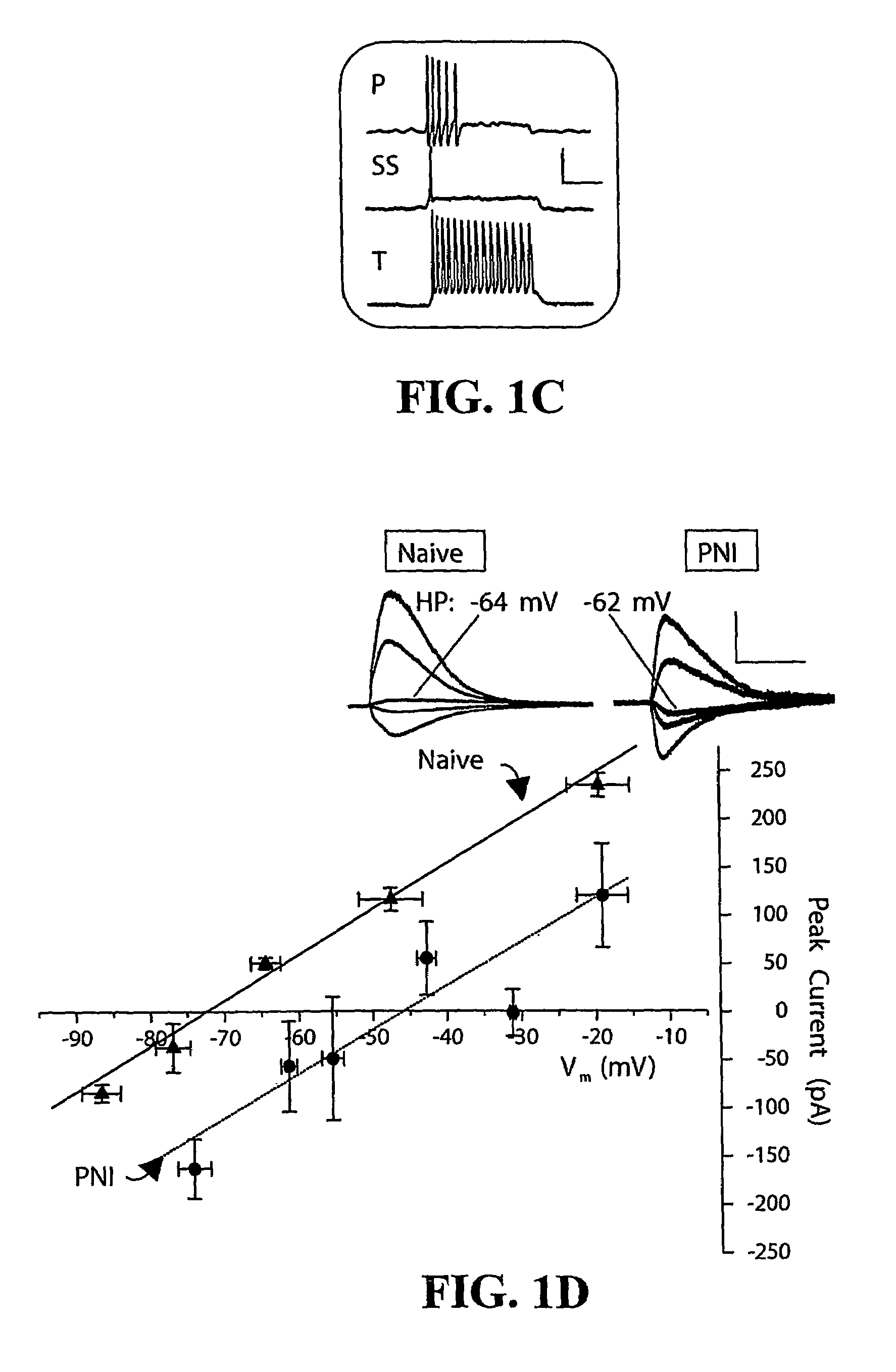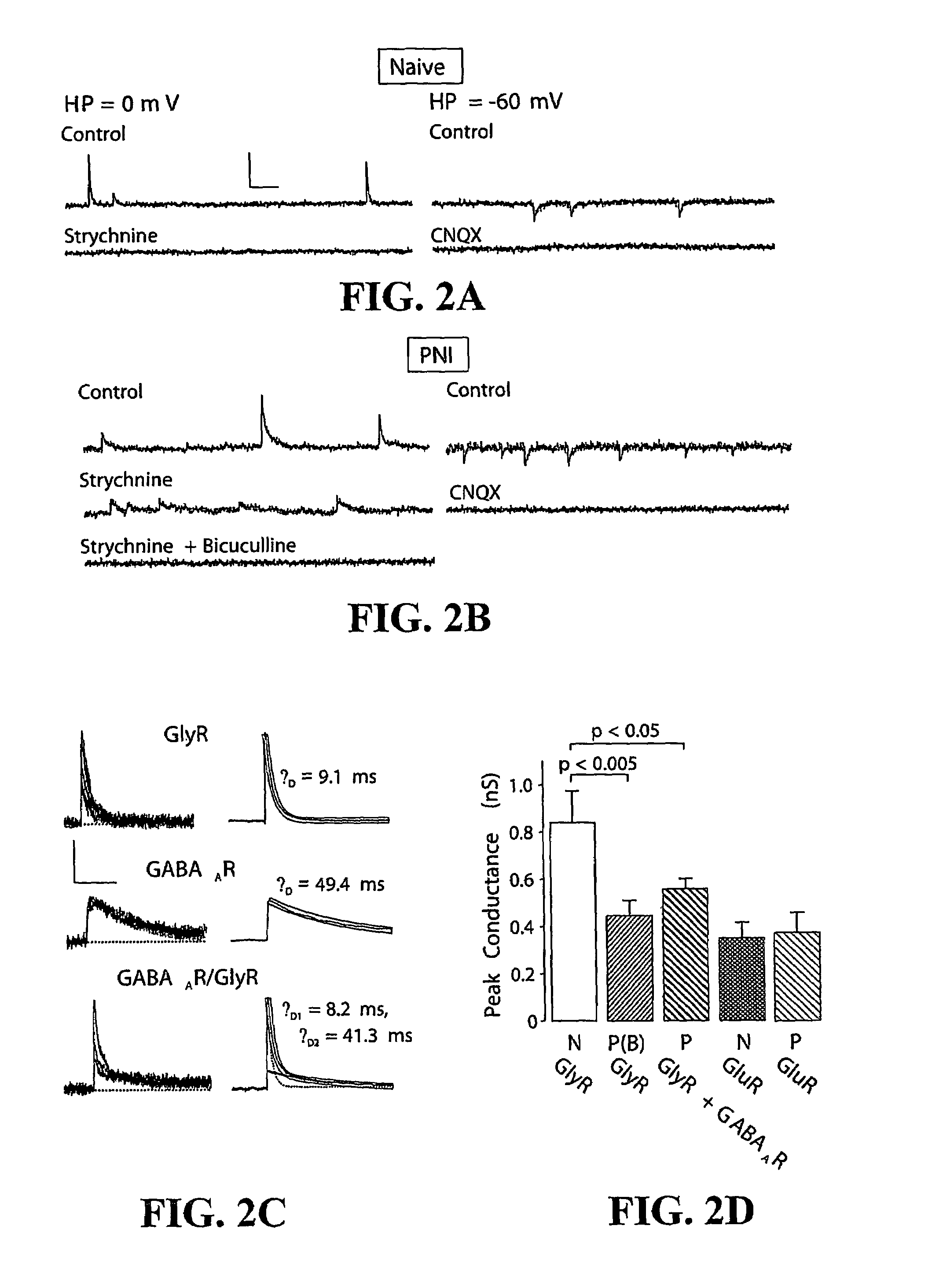Method for identifying compounds for treatment of pain
a technology of anion and neuron, applied in the field of central nervous system neuronal cell modulation, can solve the problems of affecting the recovery of patients, and severe pain, and achieve the effects of increasing kcc2 activity or expression, and reducing intracellular chloride levels
- Summary
- Abstract
- Description
- Claims
- Application Information
AI Technical Summary
Benefits of technology
Problems solved by technology
Method used
Image
Examples
example 1
Methods
[0089]Nerve Injury. Briefly, peripheral nerve injury was induced by surgically implanting a polyethylene cuff (˜2 mm long, 0.7 mm inner diameter) around the sciatic nerve of adult, male, Spague-Dawley rats as previously described (16). A group of rats also received sham surgery. Only animals that showed a gradual decrease in mechanical threshold (over 14-17 days) down to 2.0 g or less were used for further experiments.
[0090]Behavioural Testing. Thermal and mechanical threshold for nociceptive withdrawal reflexes were tested as previously described (17).
[0091]Slice preparation. Parasagittal slices (300-350 μm) of spinal cord were prepared from adult (>50 days old) male rats as previously described (9). Slices were continually superfused (2-3 ml·min−1) with artificial cerebrospinal fluid (ACSF) containing (in mM): 126 NaCl, 26 NaHCO3, 10 glucose, 2.5 KCl, 2 CaCl2, 2 MgCl2, 1.25 NaH2PO4, 0.001 TTX (bubbled with 95% O2−5% CO2, pH˜7.4); when measuring GABAA / GlyR-mediated currents,...
example 2
Results
[0100]Peripheral neuropathy was induced in rats by chronically constricting the sciatic nerve (FIG. 1a). To test whether the hyperexcitability (sensitization) of SDH neurons that follows peripheral nerve injury (PNI) is associated with modification of the anion gradient (∇anion), anion reversal potential (Eanion) was measured using gramicidin-perforated patch clamp recording. This technique avoids disrupting the intracellular anion concentration (8). Responses to exogenous GABA application showed that the anion reversal potential (Eanion) of lamina I (LI) neurons taken from PNI rats was −49.0±2.3 mV (range: −40 to −62.2 mV, n=9) compared to −72.6±3.5 mV (range: −63.0 to −79.9 mV, n=5; pb-d). Resting membrane potential was not significantly different between PNI (−62±4 mV, n=7) and naïve rat LI neurons (−61±2 mV, n=16; p>0.1). Spontaneous and evoked postsynaptic currents (PSCs), recorded from PNI rat LI neurons in the presence of fast glutamate receptor (GluR) blockers were al...
example 3
In Vitro TrkB-Dependent Modulation of KCC2
[0112]Parasaggital slices (250-300 microm) were made from the dorsal horn of naïve rats or PNI rats. Slices were continually perfused with an oxygenated Ringer's solution and were permitted to equilibrate for at least 1.5 hours prior to manipulation. Unless otherwise specified, slices were further perfused with 10 microM CNQX, a blocker of non-NMDA ionotropic glutamate receptors. Recordings were made from visually-identified lamina I neurons using gramicidin-D perforated-patch or whole-cell voltage-clamp recordings. In both cases, pipettes were filled with an intracellular solution containing either potassium methyl sulphate or cesium gluconate as the major ionic species. Eanion was measured by applying a series of brief (5-10 ms) applications of exogenous GABA to the soma of the neurons of interest; by manipulating the membrane potential of the neuron, the point at which GABA elicited neither an inward nor an outward anion current was taken...
PUM
| Property | Measurement | Unit |
|---|---|---|
| nociceptive withdrawal threshold | aaaaa | aaaaa |
| thermal melting point | aaaaa | aaaaa |
| inner diameter | aaaaa | aaaaa |
Abstract
Description
Claims
Application Information
 Login to View More
Login to View More - R&D
- Intellectual Property
- Life Sciences
- Materials
- Tech Scout
- Unparalleled Data Quality
- Higher Quality Content
- 60% Fewer Hallucinations
Browse by: Latest US Patents, China's latest patents, Technical Efficacy Thesaurus, Application Domain, Technology Topic, Popular Technical Reports.
© 2025 PatSnap. All rights reserved.Legal|Privacy policy|Modern Slavery Act Transparency Statement|Sitemap|About US| Contact US: help@patsnap.com



